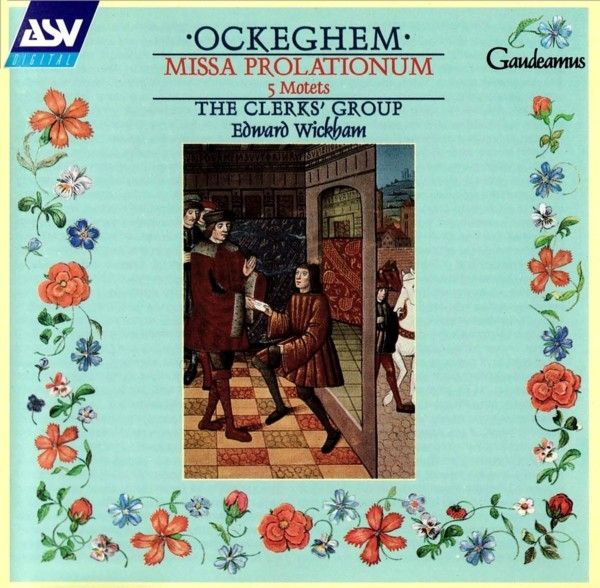
medieval.org
AS&V "Gaudeamus" CD GAU 143
1995
(?) Jacob OBRECHT
(1457/8-1505)
1. Humilium decus [5:57]
Johannes OCKEGHEM
(c.1410-1497)
Missa Prolationum
2. Kyrie [4:03]
3. Gloria [7:10]
4. Credo [8:24]
5. Sanctus [3:29]
6. Benedictus [3:36]
7. Agnus Dei [5:44]
Antoine BUSNOIS
(d.1492)
8. Gaude coelestis Domina [6:41]
9. In hydraulis [8:38]
Jean PULLOIS
(d.1478)
10. Flos de spina [4:48]
JOSQUIN
(c.1460-1521)
11. Illibata Dei virgo nutrix [6:51]
The Clerks's Group
Edward Wickham
sopranos: Carys Lane, Rebecca Outram
altos: Robin Blaze, William Missin
tenors: Stephen Harrold, Matthew Vine
basses: Jonathan Arnold, Robert Macdonald
Produced by Jonathan Freeman-Attwood
Engineered by Paul Proudman and ProudSound
Recorded at St. Andrew's Church, West Wratting, 24-25 February 1995

JOHANNES OCKEGHEM
(c.1410-1497)
It is a peculiar paradox of Renaissance polyphony that its perceived
‘complexity’ arises largely from attempts to talk or write
about it. There is nothing especially complex about hearing and
enjoying an Ockeghem mass — provided, of course, that one is
familiar with the stylistic idiom. lt is as if the music plays heavily
on the mind's capacity to take in a multitude of events happening
altogether-at-once, forcing it, by the sheer density of such events, to
abandon intensive analytical hearing in favour of a more relaxed
‘global’ hearing. The apparent complexity arises only when
one tries to understand this density of events in the linear,
one-at-a-time fashion that is inherent in speech and thought. Musical
experience itself need not (and probably cannot) involve this
cumbersome, linear processing. This may make it perhaps less conscious
of everything that is going on, but not necessarily less concentrated.
There are many activities which, with sufficient experience, can be
executed virtually effortlessly, yet can hardly be described or
explained in words without making them seem excessively complicated:
playing tennis, for instance, or even riding a bicycle. In such
activities one is forced to let go of conscious control of each
split-second decision, and instead has to put one's trust in the mind's
ability to act ‘of its own accord’ — perhaps less
consciously, but with greater speed, precision, and assurance. In the
same way it would be exhausting, and indeed distracting, if one
strained to hear and understand every detail in Renaissance polyphony:
the sheer saturation of relatively undifferentiated details opens the
mind to a broader musical experience than can be processed through the
narrow channel of analytic consciousness. And if one takes musical
experience in its double sense — as something that is undergone
and thereby also acquired — it is possible to see why repeated
hearing will make Renaissance polyphony sound less complicated and more
transparent, even if one cannot then explain it any better than, say, a
tennis player can explain the laws of ballistics.
Johannes Ockeghem's Missa Prolationum (sung here from an
edition prepared by Jaap van Benthem) is ‘complex’ in this
general sense — so typical of fifteenth-century music — in
that its musical events are not structured and organised in ways that
we may consciously listen for (say, motivic or thematic processes, or
neatly demarcated units), but just happen, seemingly at random. Yet it
is complex also in another sense, that one can hardly listen for
consciously either. The Mass is, in effect, a canon cycle, progressing,
section by section, from mostly double canon at the unison, second,
third, and so on, to double canon at the octave. And, to make things
more complicated, these canons are not always ‘strict’ in
the modern sense. Ockeghem exploits the capacity, inherent in the
musical notation system of his time, for notes to assume different
rhythmic configurations depending on the metres in which they are sung.
Thus it happens that the simultaneous realisations of a single notated
melody may differ not only with respect to pitch-level, but also with
respect to rhythmic interpretation. The overall procedure is
exceedingly complex if one tries to explain it in words, and must have
involved a great deal of patient planning and revision on Ockeghem's
part. None of this, however, is foregrounded in the musical sound
itself, which (if anything) sounds remarkably effortless and unlaboured.
Yet however the music may sound, the complexity of the canon procedures
is real, tangible on paper, not merely an artifact of attempts
to talk about it. The paradox mentioned earlier has been inverted:
while the complexity on paper is genuine, it is now the
‘effortlessness’ in sound that seems to be the artifact, an
artifact of aural perception. Nothing illustrates better than this the
peculiar fascination that Renaissance music holds for so many listeners
and scholars today. If compositions are by definition manifested in two
separate domains, notation and sound, Renaissance composers relished
exploring the paradoxes between those domains, rather than seeking to
streamline their connection. Notation was seen as more than an
efficient medium through which to arrive at sound: it was also, in
large measure, a conceptual world unto itself. Ockeghem's Missa
Prolationum operates in that world, and emerges as an exceedingly
complex work to the extent that it does. However, it operates also in
another world, and this is how it can be heard on this disc: nothing
but the present liner notes hint at the Mass's complexity, and if the
foregoing comments should create conscious awareness of anything, it is
probably the paradox more than the complexity.
Missa Prolationum is here presented in the context of five
motets by contemporary composers. One of these, In hydraulis by
Antoine Busnois, is an homage to Ockeghem, written in the first months
of 1467. At that time, as the motet text reveals, Busnois was in the
service of Charles the Bold, then Count of Charolais, but about to
succeed his father as Duke of Burgundy a few months later. In
hydraulis was almost certainly written on the occasion of a visit
by Ockeghem to the Low Countries, yet apart from the motet itself we
possess no documentation on that visit.
The remaining four motets are all found in one manuscript, copied in
the mid-1490s for the Sistine Chapel in Rome (MS 15). This is an
extremely important source for motet composition in the second half of
the fifteenth century, and certainly contains many more musical riches
than can be presented on this disc.
The six-part Humilium decus (edited for The Clerks' Group by
Henriette Straub) appears without an author's name in the manuscript,
yet is very close to the musical world of Jacob Obrecht, especially his
Salve crux. It is a Marian motet, based on two cantus firmi: the
Magnificat antiphon Sancta Maria succurre, and the tenor of the
song Cent mille escus by Firminus Caron. Whether or not Humilium
decus is accepted as a work by Obrecht, it must be ranked among the
masterpieces of motet composition in the 1480s or early 1490s.
Gaude coelestis Domina was long known as an anonymous work as
well, until it was identified recently as the ‘lost’ motet
by Busnois that was mentioned in a treatise of the music theorist
Johannes Tinctoris, written in 1472-3. This setting must be closely
contemporary with Busnois's In hydraulis, with which it shares
many stylistic similarities, especially in the second part. The cantus
firmus and text have not been identified, yet it seems likely that they
were taken from a hymn for a feast of the Virgin, possibly the Seven
Joys.
Jean Pullois's four-part motet Flos de spina is much older,
probably from the years around 1450. This is one of the most priceless
gems of mid-fifteenth-century motet composition, deservedly a very
famous work in its own time. There appears to be no cantus firmus:
melodic interest is concentrated in the lyrical top voice, the busy
figuration in the lower parts giving way to a broader sound only in the
approach to cadences. One could hardly think of a setting that would
better match the rich poetic imagery of the text (which was taken from
a Cantio for the Virgin in Christmastide). On the strength of this work
alone, Pullois, who seems to have been a close friend of Ockeghem's,
must be considered one of the most gifted composers of his time.
The disc ends with Josquin des Prez's Illibata Dei virgo nutrix,
the motet that famously incorporates the composer's name as an
acrostic. Like the previous three works it is addressed to the Virgin,
yet the plea to her is made here on behalf not of Christians in
general, but of a specific professional group: singers. There is indeed
evidence that the Virgin Mary was sometimes regarded as the patron
saint of singers (e.g. Loyset Compères motet Omnium bonorum
plena). Datings proposed for Illibata vary considerably,
but the style would seem consistent with a date in the 1470s, a decade
in which Josquin is known to have been active at the court of Savoy.
© Rob C. Wegman 1995
